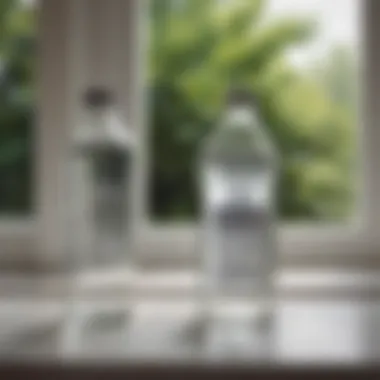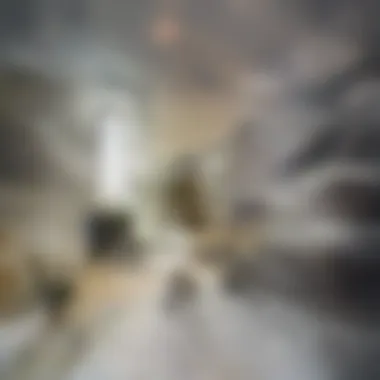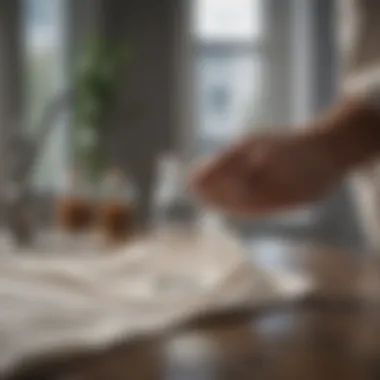White Vinegar: The Ultimate Window Cleaning Solution


Intro
White vinegar is a common household product. Many people overlook its potential as a cleaning agent. This guide will explore its effectiveness in window cleaning. By understanding how white vinegar works, you can enhance your cleaning routine.
Vinegar is made from fermented ethanol. The acetic acid in vinegar gives it its cleaning power. It cuts through grease, grime, and stains effectively. Using white vinegar for windows is simple and cost-effective. The primary goal here is to highlight how this product can help achieve streak-free shine.
In the following sections, we will cover the science behind vinegar, practical applications, and advantages compared to conventional cleaners. We will also discuss safety and environmental considerations. By the end, you will know how to use white vinegar to clean windows efficiently.
"The simplest solutions often yield the best results."
Using white vinegar is not just economical; it is also environmentally friendly. Unlike many commercial cleaners, white vinegar poses minimal risk to health and nature. This makes it a wise choice for conscious consumers.
Let’s dive deeper into the details.
Understanding White Vinegar
Understanding white vinegar is crucial in exploring its benefits and uses for cleaning windows. This simple household ingredient can serve as an effective alternative to commercial cleaning products. Its effectiveness lies not just in its ability to clean but also in its affordability and efficiency. The properties of white vinegar, from its acidity to its eco-friendliness, make it an excellent choice for maintaining clean and clear windows. Furthermore, consumers today are increasingly conscious of the products they use, particularly looking for non-toxic and environmentally safe solutions.
What is White Vinegar?
White vinegar is a clear, acidic liquid made through the fermentation of grain alcohol. It contains about 4-7% acetic acid, which is responsible for its strong smell and powerful cleaning properties. Unlike specialty vinegars, white vinegar is often used due to its affordability and easy availability. In many households, it is a staple for cooking as well as cleaning. Its versatility means it can be found in almost every kitchen, making it a prime candidate for a natural cleaning agent.
Chemical Composition
The primary component of white vinegar is acetic acid. This compound gives it its characteristic sour taste and pungent odor. The presence of water also contributes to its overall volume. The chemical formula for acetic acid is C₂H₄O₂. Besides acetic acid, negligible amounts of other organic acids might be found, but they do not significantly affect its cleaning properties. The pH level of white vinegar typically ranges from 2 to 3, which makes it acidic enough to break down grime and disinfect surfaces. The low pH is what allows it to interact effectively with dirt and stains, facilitating their removal from glass surfaces.
Common Uses Beyond Cleaning
White vinegar serves multiple purposes outside of cleaning windows. Its culinary uses include:
- Food Preservation: White vinegar is excellent for pickling vegetables. The acidic environment it creates helps inhibit bacterial growth.
- Cooking Ingredient: It enhances flavors in salad dressings, marinades, and sauces.
- Upholstery Cleaning: Beyond windows, it can also help in refreshing upholstery and carpets by neutralizing odors.
- Laundry: It can serve as a natural fabric softener and a stain remover when used correctly.
These diverse applications highlight the practicality of white vinegar in everyday life. \n
"White vinegar is not just a cleaner; it is a versatile household item that finds use in various domains, from cooking to cleaning."
In summary, understanding white vinegar and its properties leads to greater appreciation of its role in efficient and eco-friendly cleaning practices.
The Science of Cleaning
Understanding the science behind cleaning is essential for anyone looking to enhance their window cleaning routine. This section provides insights into why certain cleaning agents work effectively and how white vinegar stands out among various options. Knowing the science can boost confidence in using vinegar while ensuring optimal results.
Acidity and Its Cleansing Power
White vinegar has a specific acid level, generally around 5%. This acidity is significant because it allows vinegar to break down dirt and grime efficiently. The acetic acid in vinegar reacts with various substances, breaking them apart and making them easier to wipe away.
The acid power also plays a role in sanitization. When using vinegar on glass, this acidity can eliminate certain bacteria and pathogens, contributing to overall cleanliness. Users should be aware that the level of effectiveness can depend on how long the vinegar is in contact with the surface. Small details, like ensuring the vinegar sits on the surface for a few moments before wiping, can improve cleaning performance.
How Vinegar Breaks Down Grease and Dirt
The mechanism through which vinegar cleans involves a chemical reaction that targets stubborn residues like grease. Grease has a unique molecular structure that vinegar can disrupt. When vinegar comes in contact with grease, it penetrates the molecular bonds, loosening the dirt particles from the surface. As a result, fats and oils are broken down, making them easier to remove.
For optimal cleaning results, it's recommended to apply vinegar in a spray form directly onto the glass surface. The fine mist helps cover a larger area and allows for a thorough treatment. Following this application with a microfiber cloth or a squeegee ensures that the dissolved grime is effectively lifted away. The speed of this reaction is advantageous, leading to quicker and more effective cleaning compared to some commercial cleaners.
Comparison with Other Natural Cleaners
When comparing white vinegar with other natural cleaning solutions, it holds a unique position. For example, baking soda is often touted for its cleaning abilities; however, it serves a different purpose. Baking soda excels at scrubbing but lacks the same dissolving power against grease and grime that vinegar possesses.


Additionally, products such as lemon juice also contain acidity, but they may not be as potent as vinegar for certain cleaning tasks, especially regarding glass surfaces. The efficacy of vinegar lies in its balance of cost and cleaning capability, making it a practical choice for many.
"White vinegar is not just a culinary ingredient; its cleaning properties highlight the importance of basic chemistry in everyday life."
Preparation for Window Cleaning
Preparing for window cleaning is a fundamental step that directly influences the effectiveness and efficiency of the entire process. Without proper preparation, one can encounter various challenges that hinder achieving the desired level of cleanliness. This section outlines crucial elements to consider, ensuring a smooth and successful cleaning experience each time.
Gathering Supplies
When gathering supplies for window cleaning, it is essential to include not only white vinegar but also various tools that facilitate the task. Here are the key supplies to consider:
- White Vinegar: The star of the show, this natural cleaner effectively tackles dirt and grime.
- Water: Preferred for dilution to create the cleaning solution.
- Spray Bottle: A convenient way to apply the cleaning mixture onto the surfaces.
- Microfiber Cloths: Ideal for wiping down windows without leaving streaks.
- Squeegee: Useful for removing excess liquid and achieving a streak-free finish.
- Bucket: For mixing larger quantities of the cleaning solution if needed.
Having the right supplies organized and readily available can save time and make the cleaning process more enjoyable.
Optimal Vinegar-to-Water Ratio
Creating the right cleaning solution involves mixing white vinegar and water in appropriate ratios. A common recommendation is a 1:1 ratio, where equal parts of vinegar and water are combined. However, the ratio can sometimes be adjusted based on the degree of dirtiness.
- For lightly soiled windows, a 1:2 ratio (one part vinegar to two parts water) can work equally well.
- For windows with noticeable grime, a stronger concentration of 2:1 (two parts vinegar to one part water) might be necessary.
This flexibility allows the user to tailor the solution to specific needs.
Additional Ingredients to Enhance Cleaning
In some cases, adding other ingredients can further enhance the cleaning properties of the vinegar solution. Below are a few common additions:
- Dish Soap: Just a few drops can help break down oil and stubborn residues, providing better cleaning results.
- Rubbing Alcohol: Adding a little rubbing alcohol to the mixture helps to evaporate any excess moisture quicker, reducing streaks.
- Essential Oils: For those who desire a pleasant scent, consider using a few drops of essential oil, such as lemon or lavender, which can also provide some antibacterial properties.
Remember to mix any added ingredients thoroughly with the vinegar and water solution to create an effective cleaning agent.
Proper preparation not only leads to cleaner windows but also reduces frustration during the cleaning process.
Techniques for Cleaning Windows
Understanding the various techniques for cleaning windows is essential for anyone who seeks to maintain the clarity and sheen of their glass surfaces. This section addresses the practical methods that integrate white vinegar, ensuring that the cleaning process is not only efficient but also effective. The proper techniques can drastically enhance visibility and improve the aesthetic quality of any space, whether residential or commercial. Moreover, employing the right method can minimize streaking, which is often the bane of window cleaning.
Basic Window Cleaning Method
The basic window cleaning method utilizing white vinegar is straightforward yet effective. Start by mixing equal parts of white vinegar and water in a spray bottle. This ratio offers an optimal balance of cleaning power and cost-efficiency.
To begin cleaning, spray the vinegar solution generously on the window surface. Using a microfiber cloth or a soft sponge, wipe away the dirt and grime in a circular motion. When finished, use a squeegee to remove any excess solution from the glass, ensuring that you start at the top and move downwards. This technique reduces dripping and ensures a streak-free finish.
- Benefits of this method include:
- Accessibility of materials
- Low cost compared to commercial cleaners
- Chemical-free solution that is safe for indoor use
Cleaning Exterior vs. Interior Windows
Differentiating between the cleaning techniques for exterior and interior windows is crucial. Interior windows typically accumulate less grime but may have streaks from cleaning products used in the past. For interior cleaning, stick to the vinegar-water solution method described above.
On the other hand, exterior windows face more exposure to the elements, making cleaning a bit more involved. For exterior windows, it often helps to rinse off larger debris and dirt with a hose before applying the vinegar solution. The added water removes loose particles that might scratch the glass during cleaning.
- Important considerations include:
- Time of day: Cleaning in direct sunlight can cause the solution to dry too quickly, leading to streaks.
- Safety equipment: Consider using a sturdy ladder or extension pole when working on higher windows to ensure safety during the cleaning process.


Addressing Stubborn Stains
Despite the effectiveness of white vinegar, some stains require more persistence. For stubborn stains, such as hard water spots or bird droppings, it may be necessary to let the vinegar solution sit for a few minutes before wiping it away. In addition, consider creating a paste using baking soda and water to scrub the more difficult spots gently.
Apply the paste to the stained area, let it sit, then scrub using a soft-bristle brush. Rinse the area well with water and follow up with the vinegar solution to restore clarity.
- Tips for stubborn stains:
- Test the vinegar solution on a small, inconspicuous area first to ensure no adverse reactions occur.
- Be gentle to avoid scratching the glass, especially with abrasive materials.
Remember, consistent maintenance plays a vital role in preventing stubborn stains from forming. Regularly cleaning your windows can significantly reduce the amount of effort needed for future cleanings.
Advantages of Using White Vinegar
The advantages of using white vinegar for cleaning windows are multifaceted. This section unpacks the essential aspects, revealing how it stands out as a favorable option compared to conventional cleaners. The benefits include cost-effectiveness, a positive impact on the environment, and a non-toxic nature, making white vinegar an appealing choice for conscientious cleaning.
Cost-Effectiveness
One primary advantage of white vinegar is its cost-effectiveness. White vinegar is a readily available and inexpensive cleaning solution. Compared to commercial window cleaners, which often contain a variety of chemicals and fragrances, white vinegar offers similar cleaning efficacy at a fraction of the cost. This economic benefit cannot be overstated, especially for those who clean their windows frequently, such as in real estate or hospitality industries.
- Affordable: A gallon of white vinegar typically costs less than five dollars, making it accessible for everyone.
- Versatile: Besides window cleaning, vinegar can be used for many other household cleaning tasks. This versatility allows individuals to purchase one product that can serve numerous functions.
- Bulk Purchase Savings: Many stores sell vinegar in larger containers, reducing the cost per unit further.
Environmental Benefits
Utilizing white vinegar for window cleaning significantly contributes to environmental sustainability. Many commercial window cleaners contain harmful chemicals that can pollute water systems and damage ecosystems. However, white vinegar is biodegradable and poses minimal risk to the environment. This is particularly important for those who are environmentally aware and wish to minimize their carbon footprint.
- Non-Polluting: Unlike synthetic cleaning products, white vinegar does not release harmful toxins into the air or ground.
- Supporting Eco-Friendly Practices: By choosing white vinegar, individuals support the growing movement towards green cleaning, encouraging the use of natural products and reducing reliance on chemically steeped alternatives.
- Reduced Packaging Waste: Buying larger, single bottles of vinegar rather than numerous small cleaners minimizes packaging waste.
Non-Toxic Nature
The non-toxic nature of white vinegar is another compelling advantage. In an era focused on health and wellness, many people are cautious about the chemicals used in cleaning products. White vinegar, being a natural product, contains no harsh chemicals and is safe for both humans and pets.
- Safe for Families: Vinegar provides a safer cleaning environment for households with children or pets, reducing the risk of accidental poisonings or injuries associated with traditional cleaners.
- No Harmful Fumes: Unlike many conventional cleaners that emit strong odors, vinegar has a mild scent. This feature is particularly beneficial for individuals sensitive to strong fragrances.
- Allergy-Friendly: For those with allergies or respiratory issues, opting for vinegar as a cleaning solution can lessen symptoms related to chemical cleaners.
"White vinegar proves to be a formidable opponent against dirt, while being kinder to your wallet and the planet."
In summary, the advantages of using white vinegar as a cleaning tool are vast and varied. Its cost-effectiveness combined with its environmental and health benefits positions it as a prime candidate for anyone looking to maintain clean windows naturally and affordably.
Potential Drawbacks
While using white vinegar for cleaning windows has many advantages, it is essential to also consider its potential drawbacks. Understanding these limitations can help users make informed decisions about their cleaning choices. In the realm of window maintenance, awareness of drawbacks ensures that the use of white vinegar is appropriate and that its effectiveness is maximized.
Limitations of White Vinegar
One significant limitation of white vinegar is its effectiveness on certain types of stains. White vinegar excels at removing light dirt, fingerprints, and smudges, but it may struggle with heavier grime or stubborn marks such as paint or hard water stains. In instances where these tough stains are present, the cleaning results can be less than satisfactory. This can lead to the need for additional cleaning products, potentially offsetting some of the benefits of using vinegar as a primary cleaner.
Additionally, vinegar’s strong smell can be off-putting to some users. While the odor dissipates relatively quickly, during the cleaning process, it may be unpleasant for those sensitive to strong scents. For individuals who prefer a more fragrant cleaning experience, this could deter them from adopting vinegar as their go-to window cleaner.
Maintenance of Window Seals
Another important consideration is the effect of white vinegar on window seals. Some manufacturers utilize materials in window seals that can be sensitive to acidic substances. Repeated exposure to vinegar may lead to deterioration of seals over time. This is especially a concern for older windows or those with compromised seals. Thus, careful attention should be paid to the condition of the window seals when using vinegar for cleaning.
To mitigate potential damage, users can test a small, inconspicuous area first. Maintaining a distance while cleaning around seals is also a wise practice. This ensures that vinegar's acid does not negatively impact the longevity of the seals and keeps windows functional for longer.
Compatibility with Certain Window Types
The compatibility of white vinegar with different window types is another factor to consider. While it works well on glass surfaces, its effectiveness varies with plastic or tinted windows. For tinted windows or those with specialized coatings, vinegar may cause degradation or discoloration over time. This is particularly evident in automotive windows or specific types of doors where special finishes are present.


Users should consult manufacturer guidelines for cleaning products to avoid any potential damage. If unsure, opting for specific cleaners designed for the window type can prevent unwanted outcomes.
Safety Considerations
When using white vinegar for cleaning windows, safety considerations need careful attention. Ensuring the safe handling and storage of vinegar not only safeguards the user but also the surfaces being cleaned. Understanding the safety protocols provides a solid foundation for effective and worry-free cleaning.
Storing White Vinegar Safely
White vinegar should be stored in a cool, dry place, away from direct sunlight. This prevents the degradation of its quality. The container should be clearly labeled to avoid any confusion with other household products. A sealed bottle, preferably made of glass or food-grade plastic, is recommended. This helps maintain the integrity of the vinegar.
Remember to keep vinegar out of reach of small children and pets.
To ensure longevity, avoid transferring vinegar into other containers that are not designed for food storage. Signs of spoilage include changes in color or odor. Regularly check storage containers for integrity, looking out for cracks or leaks.
Preventing Damage to Surfaces
White vinegar is a powerful cleaner, but its acidic nature can potentially damage some surfaces if not used correctly. For example, natural stone surfaces like granite and marble may etch or lose their shine when exposed to vinegar. Therefore, testing a small, inconspicuous area before extensive use is wise.
When cleaning windows, avoid spraying vinegar directly on wooden frames or sills. Instead, apply it to a cloth first. This minimizes excess liquid that may seep into crevices. Additionally, ensure that the surface is dry after cleaning to prevent any lingering moisture which might cause wood warping or paint peeling.
- Wear gloves to prevent skin irritation, especially if cleaning with mixtures or other chemicals as well.
- Ensure proper ventilation during cleaning to avoid inhaling fumes, however mild they may be.
By following these safety considerations, you can confidently utilize white vinegar to clean your windows without compromising the surrounding areas.
Maintenance Tips for Clean Windows
Maintaining clean windows requires a strategic approach. A few key practices can enhance cleanliness and prolong clarity. First, regular attention to your windows can mitigate the buildup of stains caused by dirt, grime, and weather elements. Not only does this practice improve the appearance of windows, but it also contributes to the longevity of the glass. Ignoring window maintenance can lead to persistent stains that necessitate more aggressive cleaning methods and can potentially damage the glass over time.
Regular Cleaning Schedule
Establishing a regular cleaning schedule is vital. Depending on your environment, a cleaning frequency of every one to three months is often sufficient. Homes in dusty areas or regions with frequent rains may require more frequent cleanings. Create a schedule that aligns with your local weather conditions and seasonal changes. In doing so, you can effectively manage the window cleanliness and prevent excessive dirt buildup.
- Weekly Spot Checks: Even when following a regular schedule, perform quick inspections of your windows weekly. This helps catch any new stains before they become permanent.
- Seasonal Cleaning: Consider a more thorough cleaning during spring and fall. These seasons often accumulate more dirt and pollen due to changing weather patterns.
Seasonal Considerations
The changing seasons bring varying factors affecting window cleanliness. Understanding these nuances can enhance your window maintenance strategy.
- Spring: As the weather warms up, pollens bloom. This makes spring an essential time for cleaning, as pollen can easily settle onto glass surfaces, creating smudges.
- Summer: Increased sunlight can cause streaks and smears to become more noticeable. Consider cleaning in the evening to avoid sun reflections that can hinder visibility while cleaning.
- Fall: Falling leaves and debris can accumulate on window sills. A thorough cleaning in fall ensures that any residues do not cling onto the glass with the onset of winter.
- Winter: In some regions, windows may gather frost or ice. When moisture freezes, it can sometimes leave marks. Clear these promptly to maintain transparency. Be cautious with the cleaning approach during colder months to avoid damaging the glass or seals.
"A thoughtful maintenance routine can elevate your environment and enhance your living space's appeal."
By adhering to a carefully considered cleaning schedule and being mindful of seasonal impacts, you can maintain immaculate windows year-round. Doing so not only improves visibility but also enhances the overall aesthetic of your property, a crucial factor for real estate enthusiasts, travel lovers, and interior design aficionados alike.
Ending
Concluding this exploration on white vinegar’s application for cleaning windows illuminates several pivotal elements regarding its usage. White vinegar stands as a formidable alternative to commercial cleaners, primarily because of its effective cleansing properties derived from its natural acidity. Recognizing these benefits allows individuals to make an informed choice when selecting cleaning supplies for their homes or offices.
Summarizing the Effectiveness of Vinegar
The effectiveness of white vinegar for cleaning windows can be summarized in a few key points:
- Streak-Free Shine: White vinegar, when mixed with water, offers a streak-free finish which is highly desired for clear glass surfaces.
- Grease and Grime Removal: The acetic acid in vinegar helps break down stubborn grease and dirt without the need for harsh chemicals.
- Cost-Effectiveness: Vinegar is inexpensive compared to many commercial cleaners, making it accessible for regular use.
- Non-Toxic: Its natural composition is safer for both users and the environment, reducing exposure to harmful substances.
"Utilizing white vinegar not just cleans windows; it aligns with a broader intention of healthy and eco-conscious living."
Encouraging Eco-Friendly Practices
Encouraging eco-friendly practices is essential when discussing window cleaning. As people become increasingly aware of environmental concerns, using products like white vinegar fulfills this need. Here are a few considerations on promoting sustainable cleaning methods:
- Reduces Chemical Waste: Switching to vinegar lessens reliance on industrial cleaning products, many of which contain harmful chemicals.
- Sustainable Sourcing: Vinegar is derived from natural fermentation processes, which is fundamentally more sustainable than synthetic alternatives.
- Recycling Containers: By using vinegar, consumers can also regularly reuse spray bottles for their cleaning solutions, minimizing plastic waste.
In summary, the conclusion emphasizes the importance of understanding the effectiveness and safety of white vinegar in window cleaning. Not only does it provide practical benefits, but it also highlights a commitment to eco-friendly practices, crucial for both personal health and environmental wellbeing.







